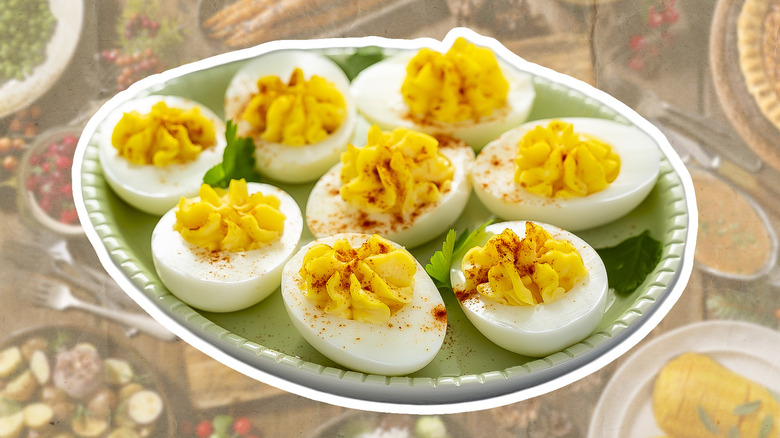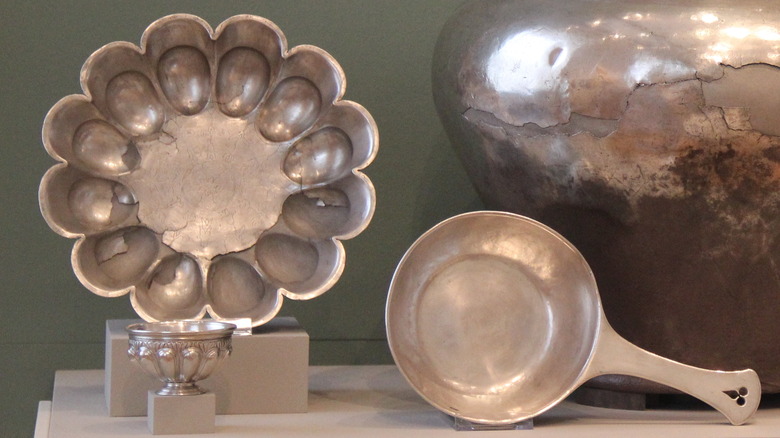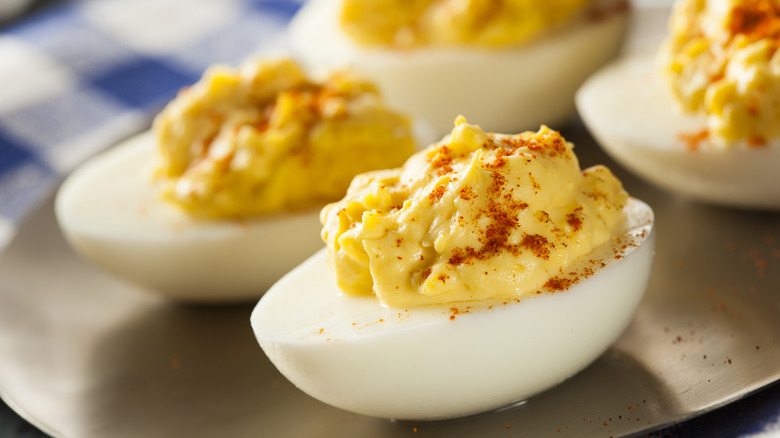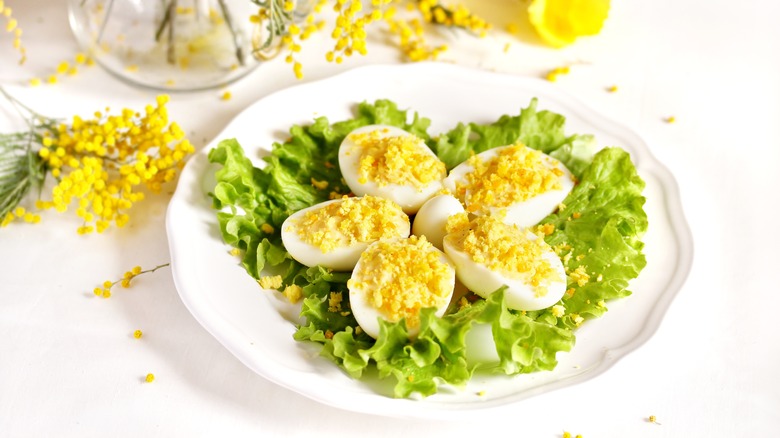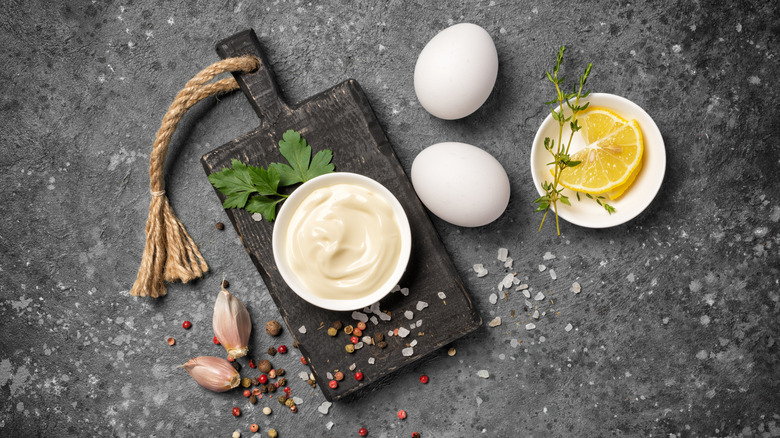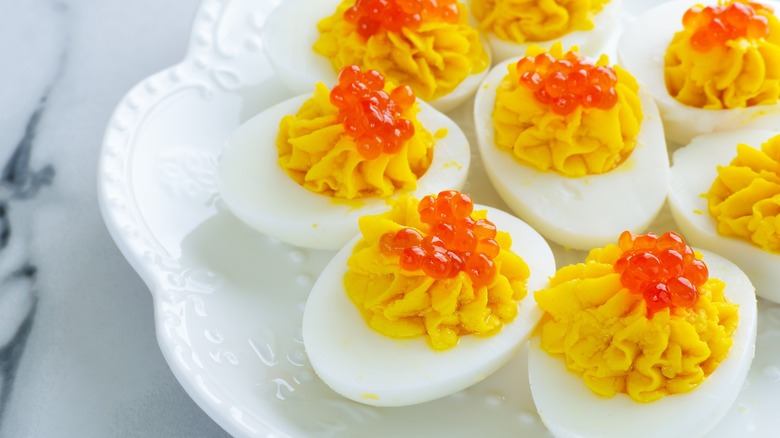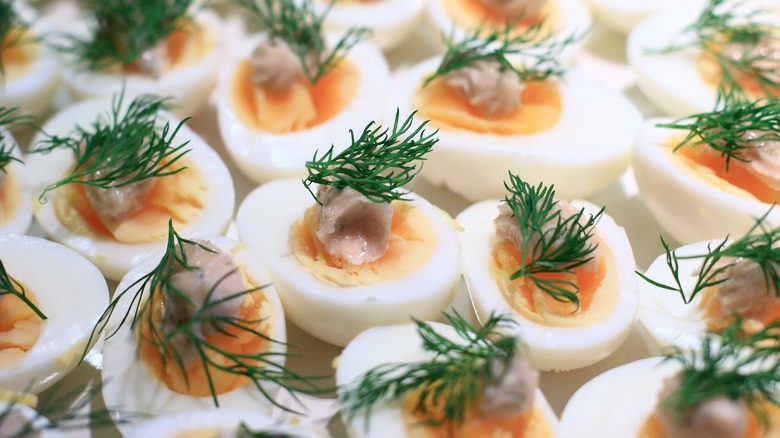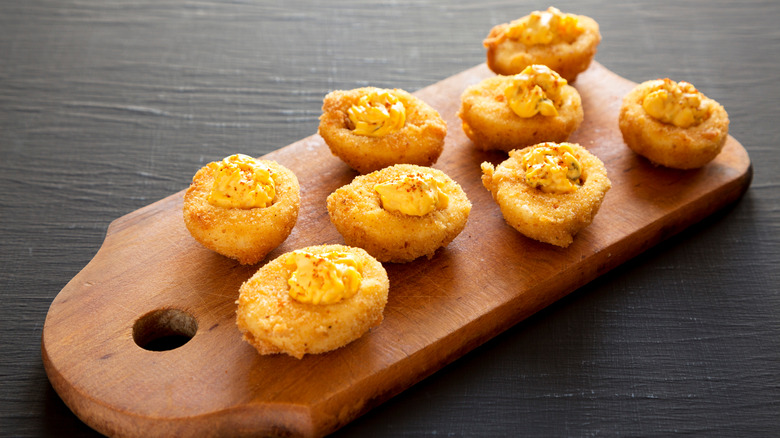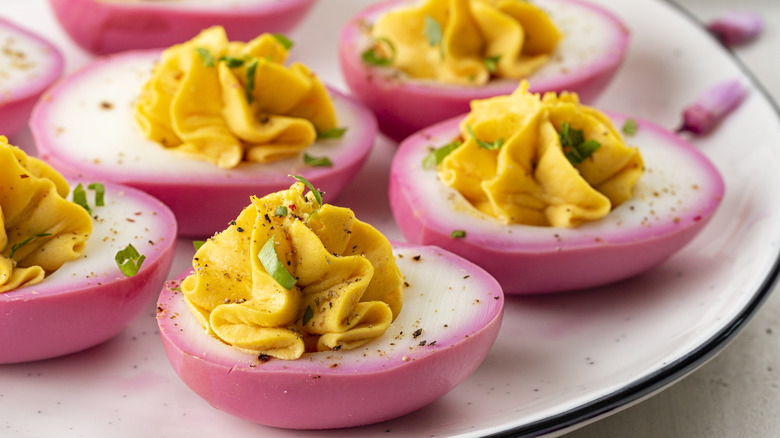How Classic Deviled Eggs Became A Potluck Star
Deviled eggs are a classic American dish. Bite-sized, spicy, and deliciously moreish, they're served all across the U.S. as hors d'oeuvres, on party buffets, and, of course, at picnics. Because it's so simple to slice a boiled egg in two, make a spiced filling from the yolk, and refill the remaining halves, there's plenty of room for variation, adding personal twists, regional ingredients, and customizing your eggs according to tastes. In the Deep South, where it's unusual to not see a plate of deviled eggs at a get-together, hot sauce is an essential ingredient to give the dish some bite!
Easter time, naturally, is an especially popular time to serve deviled eggs, with nearly two-thirds of Americans enjoying these tasty treats as a side dish on the dinner table. But they can be eaten at any time of year, and the start of summer is an excellent excuse to try out a few recipes and practice making a plate or two of them to carry when going to potluck parties, particularly if you'll be dining al fresco. With a little flair, deviled eggs can make an eye-catching addition to any buffet table. In doing so, whether you know it or not, you'll be taking part in a surprisingly long tradition!
The ancient origins of deviled eggs
Spiced boiled eggs have been a common sight at dinner tables as far back as Ancient Roman times. Although the eggs weren't served in quite the same way we do today, a few things from Roman tables are surprisingly recognizable. Roman plates have been discovered which were made specifically to serve eggs, as noted in a translated copy of the ancient cookbook "De Re Coquinaria," originally written by the Roman gourmet Apicius. The best example of one of these ancient platters (shown in the image above) was found as part of the Hildesheim Treasure, a trove of Roman silverware unearthed in Germany. It has much the same kind of design as the egg platters that became popular during the 20th century. While this silver plate may be nearly two millennia old, it wouldn't look out of place in an American family home today.
The Romans enjoyed eggs as appetizers, served with rich spicy sauces. These were such a common part of daily life at the time, particularly for the upper classes, that they had an expression, "ab ovo usque ad mala" meaning "from eggs to apples." This referred to eating a full meal, with eggs as a starter course and fruit like apples often served for dessert. However, the Romans didn't split their eggs in half or stuff them. That particular culinary invention wouldn't happen for several centuries yet to come.
A recipe from the first printed cookbook
Perhaps the oldest known recipe for anything resembling modern deviled eggs comes from Medieval Spain, first published around the 13th century in an "Anonymous Andalusian Cookbook." This is the oldest reference to splitting and stuffing boiled eggs. The finished dish was still somewhat different from the eggs served today at potluck parties, but isn't difficult to make and would certainly be an interesting talking point!
The stuffed eggs eaten centuries ago in Spain were similarly made from halved, boiled eggs, and the yolks were mixed together with cilantro, onion juice, black pepper, oil, and salt. They also used an ingredient that can no longer be found — murri, a Medieval Arab condiment made with fermented barley. In modern kitchens, certain varieties of soy sauce or Japanese miso can work as good substitutes. The biggest difference though, is that these eggs were then fastened back together using a small stick, essentially a Medieval cocktail stick.
Similar recipes for stuffed eggs were recorded in other Medieval European cookbooks over the following centuries too. In the 15th century, Platina's "De Honesta Voluptate," the first printed cookbook, includes raisins and "good cheese" in its recipe, as well as herbs like mint and marjoram. These Italian eggs were spiced with ginger, cinnamon, and clove. Another recipe from Medieval Germany uses mint and sage. The stuffed eggs eaten centuries ago were evidently no less flexible than the deviled eggs served today.
Why are they called deviled anyway?
One question that plenty of people may have wondered is why exactly the word "devil" came to be included in the name of a popular hors d'oeuvre. The word was seemingly first used in a culinary sense in the 18th century and was first recorded in writing in 1786, not in America but in Britain. At the time, it was used for its hellish connotations, referring to foods that were made with hot spices — but also sometimes to foods prepared by either frying or broiling. In the case of deviled eggs, the name most certainly referred to the spices, with mustard long being a popular ingredient in early recipes, and cayenne pepper often included too.
While the word may most commonly be used for eggs today, older recipes can still be found for several other deviled foods. Similarly hellish names can also be found in other European foods too. A good example is Italian arrabbiata sauce, where the word "arrabbiata" literally translates to "angry." Names in other American cuisines also carry the same reference too, like Fra Diavolo sauce, a spicy Italian-American invention first popularized in New York.
Alabama's stuffed eggs
It's no coincidence that deviled eggs are so popular in the Southern states of the U.S. That's seemingly where the modern dish was first served. The oldest known recipe for the deviled eggs we all recognize was from Alabama, where it was reportedly first published in a local newspaper, the Montgomery Adviser, in the summer of 1877. This recipe wasn't yet the same as the modern version, though. It called for hard-boiled eggs cut in half, with the yolks removed and mixed with melted butter, cayenne pepper, mustard powder, and a little vinegar. This appears to be the first recorded recipe where the yolk mixture was spooned back into the egg white halves and served open.
After the recipe was popularized in the Southern states, it started to find its way around to other parts of the U.S. The next year, the recipe appeared in newspapers in Indiana, Illinois, and Wisconsin too. Perhaps ironically, despite the devilish name, the dish became particularly popular at church functions like picnics and suppers.
The devil comes to the kitchen
Perhaps the first recipe collection to include deviled eggs was "The Boston cooking-school cook book," published in 1896 by Fannie Farmer. This book contains two such recipes for eggs, but both are quite different from modern deviled eggs. The recipe for Eggs Farci involves mashing the egg yolks with butter and mayonnaise and mixing in cold cooked chicken or veal before seasoning with lemon juice, mustard, and cayenne pepper. The other recipe, Stuffed Eggs in a Nest, uses a half-and-half mixture of egg yolks and deviled ham, mashed together with butter. This dish was also baked before serving.
Deviled ham was an everyday item in a lot of kitchens at the time, especially in Boston where it had been canned since 1868. Being cheap and easily available, it was often used as an ingredient in home recipes. The ham was cured with nitrites (like corned beef), as well as brown sugar, and the "deviled" in the name came from the mustard and spices it was seasoned with.
Farmer's cookbook may not contain a recipe named deviled eggs, but it does contain several other "devilled" foods, which it explains means "highly seasoned." Listed are recipes for deviled lobster, tomatoes, oysters, crab, almonds, chestnuts, and one recipe for "devilled bones" (though it actually means chicken drumsticks). Most of these contain spicy ingredients like mustard, cayenne pepper, or both. The chestnuts use Tabasco sauce.
The rise in popularity of stuffed eggs
Fannie Farmer's recipe for Eggs Farci was the first recorded to use mayonnaise to bind the mashed egg yolks together, but this wasn't an everyday ingredient at the time, and her book even contains a few recipes for it. Instead, the deviled eggs of the early 20th century used butter to bind the egg yolks and give them a soft, smooth consistency. While hot spices are now considered essential deviled egg ingredients, the early stuffed egg recipes didn't always include those either, often going by other names like stuffed eggs, dressed eggs, or mimosa eggs.
In a 1913 cookbook, "The New Hostess of To-day" by Linda Hull, an early recipe for deviled eggs contains no spices except mustard, also using Worcestershire sauce, tinned tomato pulp, and butter. It doesn't seem to mention scooping and mashing the egg yolks either, but it does suggest that these eggs should be served on toast spread with anchovy paste, which may be an unusual choice for modern palates.
Curiously, Hull's book has another recipe that's closer to modern deviled eggs, but it goes by a different name. Her Anchovy Eggs call for halved eggs, with yolks blended together with butter, anchovy paste, and minced ham, seasoned with a little pimento or paprika. Rather than being served open though, these eggs were pressed back together and resealed by using a little beaten egg white and putting them briefly in the oven.
Devilish mayonnaise
By the 1920s, deviled eggs became a much-loved dish to bring to picnics. They were so popular as a carry-along food that in 1923, Wanda Barton's newspaper column "Home-Making Helps" suggested saving egg boxes to carry them in. The dish became so widely popular that it would eventually lead to the creation of egg platters in the 1930s, designed specifically to hold deviled eggs. These were originally made from glass, but later plates in the '50s started being made of porcelain too. Because the deviled eggs were always the first dish to be finished at parties, these egg platters were designed to be very ornate, so the empty plate would still look attractive on the table.
By the 1940s, deviled eggs were an essential dish at both picnics and parties, and a more modern recipe started to be used as mayonnaise began to become a common sight in American kitchens. Until 1907, homemade mayonnaise was the only kind to be found in American cuisine. Even after it started to be available pre-made, it still wasn't commonly used because of the lack of home refrigeration to keep it fresh. It wasn't until the '30s that refrigerators started to become widely found in American homes. While mayonnaise may be a humble ingredient today, before the 1940s, deviled eggs made with mayonnaise were the reserve of gourmet chefs!
Russian eggs in Europe
There are a few variations of deviled eggs enjoyed in different parts of Europe, where they're sometimes known as Russian Eggs (not to be confused with those Russian eggs). These dishes still often include mustard, but they're less spicy than their American counterparts and don't usually involve any chili peppers. Instead, the recipe usually uses ingredients like chives and the sharp taste of pickles. Some versions can also include the addition of things like mushrooms, onions, ham, or fish. Another common variation served in Russia is topped with bright orange salmon caviar, giving two layers of eggs and two layers of flavor.
In France, people sometimes serve a variation called mimosa eggs. These are made similarly to American deviled eggs but sprinkled with crumbled cooked egg yolk to give the dish a grainy appearance reminiscent of vibrant yellow mimosa flowers. It's a fitting dish to enjoy in Southern France during the summertime, for the mimosa festivals of the French Riviera.
A Swedish Easter specialty
A Northern European version of deviled eggs is a Swedish dish known as fyllda ägghalvor (filled egg halves). These eggs are rich and creamy, with the egg yolks usually mixed with caviar, mayonnaise, whipped cream, and sometimes yogurt. While this dish isn't traditionally spicy, some people like to include a little dash of Tabasco sauce in the recipe too. They can also be topped with a variety of garnishes like chopped red onion, salmon caviar, finely diced smoked salmon, or peeled shrimp — traditionally, a lot of people insist that the shrimp used should be peeled by hand. A sprinkle of dill and chives makes the finishing touch.
Much like in the U.S., these eggs are eaten year-round but are particularly popular at Easter time. A Swedish Easter celebration typically includes a big smörgåsbord of traditional foods called a påskbord or Easter buffet. A plate of decorative fyllda ägghalvor is a classic dish to include at one of these buffets, often taking pride of place on the table. A colorful dish with seafood toppings, these eggs are usually served on a bed of fresh green baby spinach leaves.
All kinds of deviled eggs
America's Deep South is the home of deviled eggs, and they're still a common sight there. In the more pious regions of the American South and Midwest, they've been an ever-popular dish to serve at church functions since the early 20th century — though Christian communities are likely to refer to these as dressed eggs or salad eggs, to avoid any devilish references. As well as the classic version, there are also plenty of different variations that you might see if you're ever invited to a Southern party. Beet-pickled deviled eggs use boiled eggs that have been left overnight in a mixture of vinegar and beetroot juice to stain them a deep magenta color (but be careful not to let them soak too long, to stop them from becoming tough). Another colorful version uses turmeric to stain the egg whites bright sunshine yellow.
Other filling and topping ingredients can include bacon, pickled okra, or jalapeños and cilantro for Tex-Mex deviled eggs. Perhaps the most indulgent version, though, is fried deviled eggs. For these, the egg whites are coated in breadcrumbs and crumbled Parmesan cheese, then deep fried before being re-filled with the egg yolk mixture. With a wholesome flavor and a satisfying crunch, you can expect a plate of these to be quickly devoured whenever they're served!
The perfect potluck dish
Across the U.S., deviled eggs are one of the most popular items to bring along to a potluck party, as well as get-togethers of all kinds. From family functions to picnics in the countryside, they're a perfect choice for a variety of reasons. With a little practice, and some personal flair, a plate of deviled eggs can be an attractive addition to the table, needing just enough effort to be impressive but not so much that they're overly involved to prepare. What's more, eggs are an inexpensive food, so people at virtually any level of income can afford to make a plate of them. Eggs are also extremely nutritious, packed with protein and all essential amino acids as well as 13 different vitamins. In many ways, the humble egg is the closest thing there is to a perfect food.
For those who want to try something more unusual, differently styled eggs can spice things up even more, particularly if you feel brave enough to attempt one of the recipes from historic cookbooks. But, while flamboyant, it isn't essential to be quite so adventurous. As a nostalgic reminder of many people's childhood gatherings, a plate of classically styled deviled eggs will always be a good choice. No matter how often this delicious dish has graced party tables, another plate of them is unlikely to ever be turned down.
